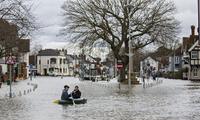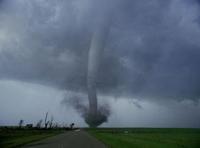-
Microgrids offer cities resiliency, reliability, accessibility
A majority of the world’s population now lives in cities, which consume 75 percent of the world’s resources and emit most of its greenhouse gases. The United Nations estimates that by 2050, an additional three billion people will move into these dense, resource-intense urban environments. The focus in cities like New York or New Orleans is on building infrastructure to make cities more resilient when faced with extreme weather or natural disasters — by providing backup power during outages, as well as helping to ease systems back online as outages end. Microgrid researchers are taking up this challenge by developing an energy solution with the potential to strengthen all three critical factors of energy in a livable city: resiliency, reliability and accessibility.
-
-
Wastewater injection induces Oklahoma quakes: study
The dramatic increase in earthquakes in central Oklahoma since 2009 is likely attributable to subsurface wastewater injection at just a handful of disposal wells, finds a new study. The researchers say Oklahoma earthquakes constitute nearly half of all central and eastern U.S. seismicity from 2008 to 2013, many occurring in areas of high-rate water disposal.
-
-
“Smart” rocks detect bridge damage
It is hard to gauge how structurally sound a bridge is when its foundation is buried in a riverbed deep below the water’s surface. New “smart” rocks which are being developed by researchers will give engineers an accurate, easy and cost-effective tool to monitor a bridge’s foundation, in real time. The leading cause of bridge collapse in the United States is scour, an erosion process where water flow carries away river bed deposits and creates scour holes around the bridge pier or abutment. Smart rocks placed at the base of bridge foundations are designed to roll to the deepest point of a scour hole and act as field agents to relay scour depths.
-
-
The price tag of the 2° climate target
Addressing climate change will require substantial new investment in low-carbon energy and energy efficiency — but no more than what is currently spent on today’s fossil-dominated energy system. To limit climate change to 2° Celsius, low-carbon energy options will need additional investments of about $800 billion a year globally from now to mid-century, according to a new study, but much of that capital, however, could come from shifting subsidies and investments away from fossil fuels and associated technologies. Worldwide, fossil subsidies currently amount to around $500 billion per year.
-
-
DHS top priorities: addressing terrorism, cyberthreats, and extreme weather risks
In its second quadrennial review, DHS outlined the department’s efforts to enhance the five homeland security objectives detailed in the first review, issued in 2010. Combating terrorism remains DHS’s primary mission, but recent disasters, including the Deepwater Horizon oil spill in 2010, Hurricane Sandy in 2012, and domestic terrorism events such as the Boston Marathon bombings in 2013, along with cyberthreats against the nation’s infrastructure, have led the agency to adopt a risk-based approach to significant threats from both terrorism and natural disasters.
-
-
U.K. infrastructure facing tough challenges as extreme weather events multiply

The U.K. Institute of Civil Engineering’s (ICE) State of the Nation: Infrastructure 2014 report has highlighted the fact that more frequent extreme weather events will make it increasingly difficult to operate U.K. infrastructure networks in all conditions at the level of service U.K. residents have come to expect, and people’s expectations of availability will need to change. The report grades the U.K.’s Transport, Energy, Flood, Waste, and Water networks from A to E, suggesting more needed to be done if the United Kingdom is to have world class infrastructure.
-
-
Syrian Electronic Army’s attack on Reuters makes a mockery of cyber-security (again)

One big security issue that has arisen lately concerns control of news media. National boundaries have become blurred on the Internet, and the control any nation can have over information dissemination has been eroded — on news Web sites but especially on open platforms such as Twitter and Facebook. One lesson from all the attacks on open platforms is that a focus of any attempted hack will be a spear phishing e-mail. Tricking users into entering their details may be simple, but it can be very serious. For example the Reuters site, which was attacked by the Syrian Electronic Army (SEA), a pro-Assad group of “hacktivists,” integrates more than thirty third-party/advertising network agencies into its content. A breach on any of these could compromise the agency’s whole infrastructure.
-
-
Net energy analysis should regarded as a standard policy tool: scientists
It takes energy to make energy, whether it is renewable or a fossil fuel. Net energy analysis gauges the sustainability of energy technologies over time. Net energy analysis provides a quantitative way to compare the amount of energy a technology produces over its lifetime with the energy required to build and maintain it. The technique can complement conventional energy planning, which often focuses on minimizing the financial cost of energy production, Stanford researchers say.
-
-
U.S. Northwest prepares for the Big One
Seismologists believe the Pacific Northwest is overdue for an earthquake that could register at over 8.0 on the Richter scale, leading many emergency management professionals in the region to anticipate and prepare for the devastating impact such an event would have on the local economy. Experts talk about Triple 3 Resilience Target as a the goal for managing the aftermath of an earthquake: have emergency services running within three days; level of services to sustain the economy within three weeks; and a target of three years to stabilize the economy and prepare for future disasters.
-
-
Heavier oil train traffic in western U.S. causes safety worries
In May, following extensive debate regarding security concerns, U.S. Transportation Secretary Anthony Foxx ordered railroads to share oil train shipment information with states, in order better to inform first responders should an accident occur. In the first quarter of 2014 alone, there were 110,000 carloads of oil. Each train can carry three million gallons of oil.
-
-
Tornado threat in Tornado Alley can be eliminated by building walls: scientists

In the United States, most devastating tornadoes occur in Tornado Alley, which is a strip of land between the Appalachian Mountains and the Rocky Mountains, including most American Midwest states. In 2013, there were 811 confirmed tornadoes in the United States, 57 in Europe, and 3 in China. Among 811 tornadoes in the United States, most, especially the most devastating ones, occurred in Tornado Alley. Scientists say that building three 300 meter high and 50 meter wide walls, at the cost of about $160 million each — the first close to the northern boundary of the Tornado Alley, maybe in North Dakota; the second one in the middle, maybe in the middle of Oklahoma and going to east; the third one in the south of Texas and Louisiana – would significantly reduce, if not eliminate altogether, the threat of devastating tornadoes in Tornado Alley.
-
-
As Baby Boomers retire, nuclear industry faces manpower shortages
Many nuclear power plants in the United States are facing an employment and training crisis as their largely Baby Boomer-generation (1946-64) workforce begins to retire. The nuclear industry is making an effort to usher in new and better-trained workers — many from university programs and former military service — to fill in the gaps created by retirement-aged engineers.
-
-
Making nuclear power plants more resilient during earthquakes
Researchers in Finland are examining current nuclear power plants’ structure to see where improvements could be made to make them more resilient during earthquakes. Finland currently is building new nuclear power plants, and within ten years, the country expects to be getting 60 percent of its electricity from nuclear plants.
-
-
N.C. “rolling” 30-year sea level rise report gaining support from both sides
In 2010, coastal developers and Republican legislators in North Carolina were alarmed when a state science panel warned that the Atlantic Ocean is expected to increase by thirty-nine inches along the state’s shores by the end of the century. The state legislature soon ordered a four-year moratorium on official sea-level predictions and gave the Coastal Resources Commission(CRC) guidelines for developing a new official state forecast. In May, Frank Gorham III, chairman of the commission, announced that the next forecast will only predict sea-level rise for the next thirty years, a time span during which model-based predictions about sea level rise along the North Carolina coast – about eight inches — are largely accepted by both sides to the climate change debate. Gorham stresses, however, that he wants a “rolling” 30-year forecast to be updated every five years.
-
-
Experts urge deployment of earthquake warning system in California
Scientists say that California has “99.7 percent chance of experiencing a severe earthquake — magnitude 6.7 or higher on the Richter scale — within the next 30 years.” These scientists are urging Congress to consider funding the full-scale deployment of an early-warning earthquake system on the western coast of the United States following successful testing of a prototype and positive results from similar international systems.
-
More headlines
The long view
Water Wars: A Historic Agreement Between Mexico and US Is Ramping Up Border Tension
As climate change drives rising temperatures and changes in rainfall, Mexico and the US are in the middle of a conflict over water, putting an additional strain on their relationship. Partly due to constant droughts, Mexico has struggled to maintain its water deliveries for much of the last 25 years, deliveries to which it is obligated by a 1944 water-sharing agreement between the two countries.
Trump Is Fast-Tracking New Coal Mines — Even When They Don’t Make Economic Sense
In Appalachian Tennessee, mines shut down and couldn’t pay their debts. Now a new one is opening under the guise of an “energy emergency.”
Smaller Nuclear Reactors Spark Renewed Interest in a Once-Shunned Energy Source
In the past two years, half the states have taken action to promote nuclear power, from creating nuclear task forces to integrating nuclear into long-term energy plans.
Keeping the Lights on with Nuclear Waste: Radiochemistry Transforms Nuclear Waste into Strategic Materials
How UNLV radiochemistry is pioneering the future of energy in the Southwest by salvaging strategic materials from nuclear dumps –and making it safe.
Model Predicts Long-Term Effects of Nuclear Waste on Underground Disposal Systems
The simulations matched results from an underground lab experiment in Switzerland, suggesting modeling could be used to validate the safety of nuclear disposal sites.
